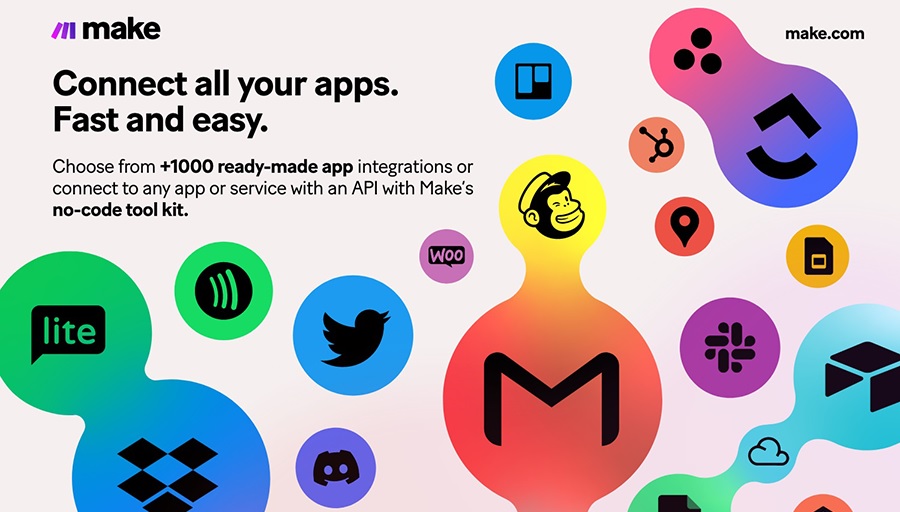
Make stands out as one of the most powerful automation platforms because of its massive library of over 2,500 app integrations. Whether you’re connecting CRMs, email platforms, HR tools, finance systems, or niche apps, chances are Make has a connector ready for you. But with so much choice, the challenge isn’t finding integrations – it’s knowing how to use them strategically. In this guide, we’ll explore practical strategies, detailed examples, and best practices for mastering Make’s app integrations while keeping your workflows scalable and efficient.
Contents
- Why Integrations Matter More Than Ever
- How Connectors Work in Make
- Strategies for Working with 2,500+ Connectors
- Examples of Powerful Integrations in Action
- Scaling Integrations Across Departments
- Challenges of Large-Scale Integration
- Best Practices for Success
- Looking Ahead: The Future of Integrations in Make
Why Integrations Matter More Than Ever
Most teams use dozens of apps every day. Without integration, those apps operate in silos, forcing employees to copy and paste data, duplicate tasks, and manually update records. Integrations eliminate this friction, creating seamless workflows where information flows automatically. The result is faster decision-making, fewer mistakes, and more time for high-value work. With 2,500+ connectors, Make offers one of the broadest integration ecosystems available.
How Connectors Work in Make
A connector is Make’s link to an external service. Within each connector are modules – triggers, actions, and searches – that define what you can do. For example, the Slack connector might let you send messages, watch new channel activity, or archive files. Combining modules from different connectors allows you to stitch together workflows that span multiple tools, from marketing and sales to finance and HR.
👉 Sign up for a free Make account
Strategies for Working with 2,500+ Connectors
1. Start with mission-critical apps
Instead of connecting everything at once, begin with your business’s core apps – CRM, project management, email, chat, and finance tools. Solve pain points where integration has the highest impact, then expand gradually.
2. Use templates as blueprints
Make’s template library provides popular app combinations already wired together. Even if you don’t copy them directly, they’re excellent learning resources for seeing how connectors interact.
3. Standardize app usage across teams
Different departments may prefer different apps for the same function (e.g., Dropbox vs. Google Drive). Without standardization, integrations get messy. Align teams on a set of core tools before scaling workflows.
4. Keep integrations efficient with filters and routers
Sending all data to all connected apps can overload systems and create noise. Use filters to restrict what passes through, and routers to branch workflows logically. This keeps workflows lean and purposeful.
5. Stay mindful of API limits
Many apps impose quotas on API calls. Ignoring these can cause workflows to fail. Always check app-specific documentation and design workflows to respect limits, such as batching actions instead of sending them individually.
6. Secure your connections
Integrations often involve sensitive data. Regularly audit connections, rotate tokens, and remove unused authorizations. Apply the principle of least privilege – only grant access where absolutely necessary.
7. Document everything
With hundreds of possible integrations, documentation is essential. Record what connectors are used, what data flows through them, and who is responsible for maintaining each workflow. Good documentation prevents chaos when staff change or systems evolve.
Examples of Powerful Integrations in Action
Marketing and Sales
A company connects Facebook Ads, HubSpot, and Slack. New leads are captured, enriched with data from LinkedIn, and pushed to sales reps in Slack instantly. Custom filters ensure only complete leads are shared, saving sales teams from chasing bad data.
Customer Support
Support teams integrate Zendesk, Google Sheets, and Gmail. Every ticket is logged into a spreadsheet for analytics, summarized weekly, and sent as a report to managers – completely hands-free.
Finance Operations
Invoices arriving in Gmail are automatically saved to Google Drive and logged into QuickBooks. A Slack notification alerts managers when high-value invoices are detected, adding a layer of oversight without extra manual work.
Human Resources
New hires entered in BambooHR trigger a series of workflows: account creation in Google Workspace, Slack introductions, and calendar invites for onboarding sessions. HR teams save hours of repetitive setup.
Scaling Integrations Across Departments
As your organization grows, so does integration complexity. Without governance, workflows can become unwieldy. Here’s how to keep things under control:
- Modular workflows: Break down large workflows into smaller, reusable scenarios for easier troubleshooting.
- Naming conventions: Label scenarios and connectors consistently to avoid confusion.
- Ownership: Assign each workflow an owner responsible for monitoring and updates.
- Regular audits: Review workflows quarterly to retire outdated connectors and optimize active ones.
Challenges of Large-Scale Integration
While Make’s integration power is unmatched, challenges remain:
- Overcomplication: Too many connectors can lead to tangled workflows that are hard to manage.
- Maintenance burden: Each app update or API change can ripple through your workflows.
- Data fragmentation: Without strategy, integrations can create inconsistent records across systems.
- Security risks: More connections mean more points of potential vulnerability.
Best Practices for Success
- Focus on quality over quantity – connect what’s truly essential.
- Prototype workflows in stages before rolling them out widely.
- Include error handling like retries, notifications, and fallback actions.
- Build human checkpoints into sensitive workflows like finance or HR.
- Train team members to understand how integrations work, not just use them.
Looking Ahead: The Future of Integrations in Make
Make’s ecosystem continues to grow, adding new connectors regularly. Expect AI-driven recommendations that suggest the best apps to integrate based on your usage patterns. Security features will also become stronger, helping organizations manage risk as integration scope expands. The future isn’t just more connectors – it’s smarter, safer, and more strategic integrations.
With 2,500+ app connectors, Make is a powerhouse for building connected, automated workflows. But real success doesn’t come from connecting everything – it comes from integrating strategically. By starting with core apps, documenting processes, and scaling with governance, you’ll harness Make’s full potential without creating chaos. The result is an automation system that grows with your business, reduces manual work, and makes your tech stack greater than the sum of its parts.

